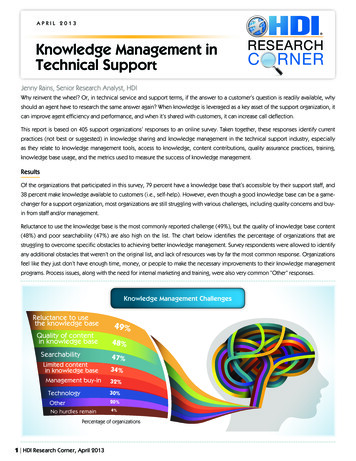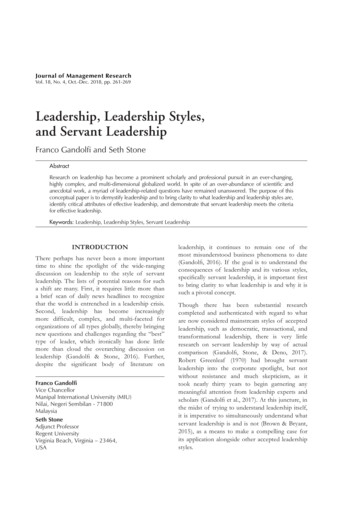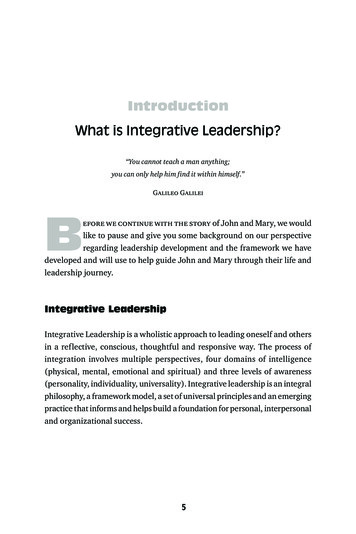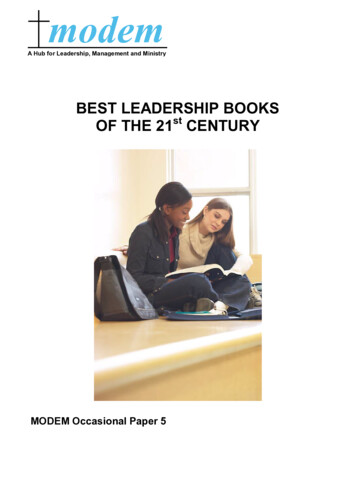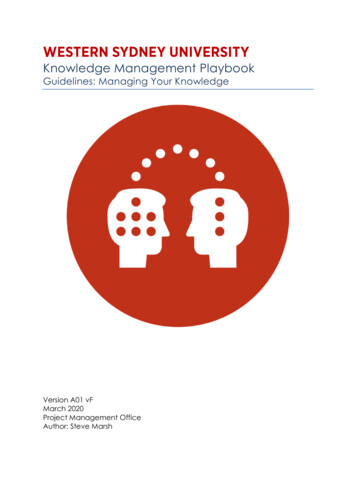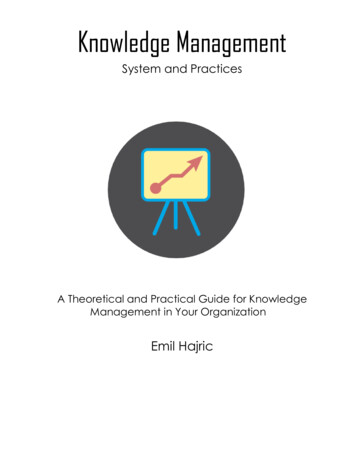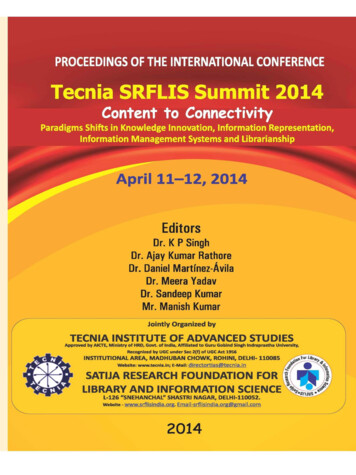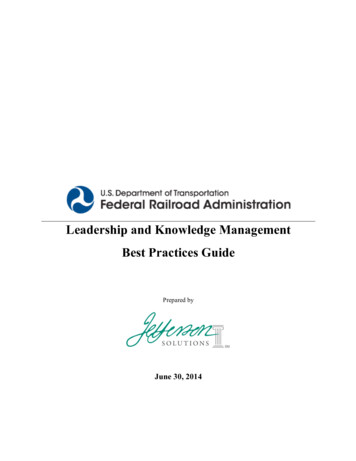
Transcription
Leadership and Knowledge ManagementBest Practices GuidePrepared byJune 30, 2014!!
ContentsLeadership and Knowledge Management Best Practices Guide . 3Onboarding . 3Benefits of Onboarding . 4Onboarding Model . 4Leading Practice: NASA Center Employee Orientation Guidelines . 4Sample Process: Onboarding Program . 8Knowledge Management . 12Knowledge Management Vehicles . 12Supporting a Culture of Knowledge Sharing . 13Leading Practice: The Role of a Knowledge Management Officer (KMO) in Effective KnowledgeSharing . 13Sample Process: Supporting a Culture of Knowledge Sharing Through the Systematic Use of TeamConversational Tools . 14Knowledge Management Best Practices . 20Succession Planning . 21Why Succession Planning? . 21What is Succession Planning? . 23Who Benefits from Succession Planning?. 24Characteristics of a Good Succession Management Strategy . 25Leading Practice: FDIC Succession Management Program. 26Example Process: Succession Planning . 28Leadership Development . 41OPM Leadership Development Matrix: . 43Leading Practice: Leadership Development Program VA Medical Center, Milwaukee WI . 51FRA HR Best Practices Guide !!2
LEADERSHIP AND KNOWLEDGE MANAGEMENTBEST PRACTICES GUIDEThrough its Strategic Human Capital Plan, the Federal Railroad Administration (FRA) has theopportunity to establish direction for major human capital initiatives, including: Creating a Unify FRA culture that integrates all program offices around it safety missionKeeping pace with the rapid changes in technology in the rail industry in order to meet itsregulatory roleReplacing those who retire in the next 5 years, especially those in leadership positionsThis best practices guide leverages the human capital expertise and decades of experience of the Jeffersonteam by capturing proven approaches in four key opportunity areas: OnboardingKnowledge ManagementSuccession PlanningLeadership DevelopmentThe guide summarizes key principles that can guide the implementation of programs in these areas,provides examples of processes that have been utilized successfully in the public and private sectors, andprovides case studies illustrating leading practices. As human capital initiatives are undertaken at FRA,this guide can serve as a resource for identifying and implementing successful approaches.OnboardingOnboarding is a process designed to strategically integrate new employees into their jobs and theorganizational environment. An effective onboarding program provides new employees with the tools andresources they need to succeed, from the moment they accept the offer of employment through the newemployee’s first year with the organization. Onboarding programs strategically align to the organization’smissions and vision; therefore, the involvement of senior leadership is critical to their success.Organizations use onboarding programs to improve employee performance, increase employeeengagement and retention, and reduce time-to-productivity. Additionally, onboarding programsdemonstrate an organization’s commitment to retaining and developing new employees, and provide aconsistent experience for all new hires, regardless of location.OPM’s “End2End” hiring report describes the onboarding process as the method of educating newFederal employees about the civil service, their specific organization (its mission, culture, structure,systems and resources), the duties of their job, and responsibilities of serving as a Federal employee andbenefits.Onboarding is a process that is ongoing and may last up to a year. It is designed to anticipate the needsand concerns of new employees, as well as provide vital information to directly accelerate employeeproductivity. The process involves a series of developmental and acculturating activities that are plannedand then delivered at stages matching employees’ information and skills gaps.FRA HR Best Practices Guide !!3
Benefits of OnboardingThe onboarding process benefits both the organization and the individual. By providing new employeeswith detailed information about the organization and their jobs, they will be able to work independentlyand contribute to their organization in a shorter time period. They will also gain insight into what makesorganizational systems more effective and efficient.An effective onboarding process assures new employees they made the right career choice in joining theorganization, they will experience greater job satisfaction and they will receive the necessary foundationto progress in their careers. Employees will have a sense of belonging and will have a clear understandingof how their jobs impact the organization. A good onboarding process is designed to show immediatedividends because employees are highly engaged from the beginning of their employment and retentionrates for new hires should increase.Onboarding ModelThe model below was developed by the Partnership for Public Service and Booz Allen Hamilton. Itprovides a framework for understanding the component activities involved in an effective onboardingprogram from the first day on the job through the first year.Leading Practice: NASA Center Employee Orientation Guidelines16 Guidelines to Ensure a Successful ProgramEach Center, organization, supervisor, and employee has a responsibility to ensure that our newemployees’ first days on the job provide a successful launch to their careers. It is critically important thatwe provide them with the foundation tools, resources, and organizational perspective that ensure theirrapid inclusion within our workforce and our NASA culture.The following guidelines are intended to communicate in our words, actions, processes, and appearance--that Safety, the NASA Family, Excellence, and Integrity are what we value. They also intended to createthe excitement and belief that, “Wow, this is going to be a great place to work!” New employees will beelectronically surveyed to ensure that we are following these guidelines.FRA HR Best Practices Guide !!4
1.2.3.4.5.6.7.8.9.10.11.12.13.14.15.16.Designate a Center Employee Orientation ManagerAssign SponsorsEnsure a successful First Day ExperienceOffer LetterOrientation WebsiteOnline Checklist BuilderOnline CalendarWorkforce Transformation & Tracking SystemNew Employee RecognitionPromotional ItemsTraining Support for OrientationFunctional Area Support of OrientationSecurity: First day ReceptionWork Area PreparationOrganization and PositionOversight, Metrics, and Feedback Response1. Designate a Center Employee Orientation Manager and assign organization responsibility forthe Center Orientation process. Your Employee Orientation Manager is responsible for thefollowing: Coordinating and monitoring the orientation of new, transferring, detailed, and returningemployees at your Center; Ensuring that your Center has an effective level of Center unique orientation activities andtraining; Familiarizing supervisors, functional areas, and sponsors with their Employee Orientationroles and responsibilities Responding to issues and feedback from orgs, employees, supervisors Monitoring performance metrics; reporting and measuring program compliance and success; Ensuring the quality of your Center’s information on the agency Employee Orientationwebsite and within the checklist builder and calendar2. Assign Sponsors. Implement the requirement that the gaining organization / supervisor assignssponsors for their new, transferring, or detailed employees. A common theme and request fromour new employees is for assistance with the day-to-day activities needed to get settled into theirnew workplace and local area. Basically, a sponsor is your new employee’s temporary best friendtasked with helping them get settled into your Center. Typically the sponsor should be of similarbackground as the new employee (occupation, organization, grade-level etc.). The sponsor willassist the new employee from the time of the offer to about a month after arrival. Detailedsponsor guidelines, a custom checklist builder for sponsors, and a brochure are available on theOrientation web page. In Phase 2, you will be asked to post the name and contact information foreach sponsor assigned to the new employee in the Workforce Transformation Tracking System(WTTS).3. Ensure a successful First Day Experience. The manner in which we prepare and receive ouremployees on their first day is absolutely critical to a successful orientation. The goal is to ensurethat upon arrival the new employee is welcomed with courtesy and attentiveness, that inprocessing is efficient and organized, that the new employee’s work location is prepared with aPC, phone, user accounts, and email address, and that their supervisor/ organization is preparedfor their arrival.Your Center should ensure that employee orientation is accepted as a shared responsibilityFRA HR Best Practices Guide !!5
4.5.6.7.8.9.10.11.between human resources, the supervisor/organization, and the functional areas (IT, facilities,security, safety, etc.,). Suggested steps for a successful First Day Experience are posted on thewebsite and are included within the checklists and in the supervisor/sponsor guidance. Note:Phase 2 implementation of the Workforce Transformation tracking system (WTTS) later thissummer will provide you with the automated tools to easily notify and involve functional area,supervisor, and sponsor, and organizations.Offer Letter With each employment offer letter, provide: The NASA Employee Orientation brochure with instructions on employee orientation and thechecklist builder. (Download from the website) A list of key contacts using the format on the website. (Download from the website in fillablePDF format).Orientation Website Maintain your Center’s content on the NASA Employee OrientationWebsite. Assist in the maintenance of the agency-wide pages.Online Checklist Builder Maintain your Center’s orientation checklist items within the onlineChecklist Builder.Online Calendar Post your Center’s orientation activities on the Employee Orientation OnlineCalendarWorkforce Transformation & Tracking System Post and maintain current gain, transfer,detail, military returnee, and loss information within the Workforce Transformation TrackingSystem (WTTS).New Employee Recognition Communicate and reinforce the sense of importance of the arrivalof your new employees. Supervisor and sponsor should contact welcome the new employee immediately after theiracceptance of the job offer. Provide a Welcome letter from the Center Director Have the gaining supervisor swear in the new employee in the presence of their co-workers Introduce the new employee to their chain of management, key staff, and key serviceproviders within the first week. Hold periodic welcoming receptions / luncheons for new employees Upon completion of employee orientation hold a short ceremony to present the completioncertificate and a NASA lapel pin. Officially, welcome the new employee to the community ofaviation and space explorers.Promotional Items Provide promotional items to new employees to help instill a sense of mission, purpose,responsibility, and identity. Items may include NASA pins, posters, photos, certificates, cups,etc. Note: many of these items are available through the Space Flight Awareness (SFA)program. Also, if available, provide coupons and flyers from the gift shop, cafeteria, visitor center,credit union, etc.Training Support for Orientation List Employee Orientation as a training course in your catalogue. Supervisory---Provide training during your Center’s supervisory training that focuses onemployee orientation roles, requirements, and practices. New and Transfer Employees--a. Provide an individual development plan (IDP)b. Provide a local briefing on training processes and opportunities.c. Ensure that required training (safety, IT Security, Hazmat, etc.) is completed withinthe specified times listed on the checklists.d. Provide Center level training that familiarizes the new employee with the AgencyFRA HR Best Practices Guide !!6
12.13.14.15.and Center roles and missions, organization, employee roles, rights, andresponsibilities, and Safetye. Provide Organizational and job level training that is required for the new employee’sjobf. Provide organized tours of faculties and Centerg. If available, have the new employee take a visitors tour of your facility along withregular visitors/ tourists.Functional Area Support of Orientation (safety, security, legal, IT, facilities, etc.) Prior to the arrival of your new employee, implement a process that ensures that yourCenter’s functional support areas are aware of the date of the arrival along with any specialneeds. Note: This will be an automated service through WTTS websites and email. Maintain an email distribution list of functional area new employee contacts and serviceproviders Provide employee orientation familiarization training to functional area representativesinvolved in orientation processes. Ensure that they are aware of their role and responsibilitiesas posted on the website, checklist builder, calendar, First day Experience requirements. Provide survey feedback from new employees and supervisors to the functional areas;Recognize outstanding service. Request corrective action for inadequate service.Security: First day Reception Security should be notified no later than three working days in advance of a new arrival ifpossible. Security should welcome the new employee with courtesy and attentiveness. New employee should be provided a temporary badge; safety, parking & traffic instructions;directions and a map, information about obtaining their permanent badge. Security should be provided a contact number for clearance or in case any difficulties occur. If possible, the sponsor or supervisor should meet the new employee at Security and providean escort to the in-processing location.Work Area Preparation The new employee’s work location / office should be prepared beforethe new employee’s arrival to include; Desk and chair and other required furniture Computer, user ID / temp password, Email address Welcoming emails from their new coworkers, management chain, and key personnel. Phone and assigned phone number / Phone instruction booklet Office, phone, and PC should also be prepared to meet any handicap requirements. Welcome letter from the Center Director Employee Orientation Brochure Organization chart showing the new employees position in the organization. List of useful contacts with phone number/email address. Include Supervisor, Sponsor,Administrative Officer, human resources specialist, benefits specialist, relocation / travelcontact. Use format provided on website. Center, Agency, Space Flight Awareness materials including NASA lapel pin, photos, cupsetc. should be provided.Organization and Position Within the first two weeks the employee should be familiarized withthe following: Job responsibilities, position description, job classification Performance plan and expectations, performance ratings Individual development plan (IDP) and required training Organization’s functional statement including organization roles and missions Management chain and the new employee’s position in the organizationFRA HR Best Practices Guide !!7
NASA Strategic Plan, Vision for Space Exploration, Center implementation plan, NASA Initiatives including Safety, One NASA, etc.16. Oversight, Metrics, and Feedback Response The continuing success and impact of theEmployee Orientation program is dependent upon continuous maintenance and improvement.Your center should: Solicit continuous feedback through the website, focus groups, and training evaluations. Report the metrics along with recommendations periodically but at least every six monthsdepending activitySample Process: Onboarding ProgramAn effective onboarding program requires the collaboration of many different parties within anorganization. The process below provides one example of what this process may look like.Phase 1: Before the First DayBuilding the Foundation - prior to the arrival of new employees Define roles and responsibilities for the on-boarding processDevelop and test a notification process to assure that the information about new hires is receivedand communicated in a timely fashionBefore the onboarding process isTrain supervisors, sponsors/buddies, HR specialists andimplemented, the agency shouldrecruiters on the agency’s orientation process andestablish an organization-wide plan fortheir roles in the processcommunication and coordinationTrain recruiters on how to link mission accomplishmentaround the arrival of each newto the positions they are recruiting for in an effort toemployee. This requires agreement onbuild excitement and sense of impact that the newthe duties and responsibilities of eachemployee will haveparticipant in the process.Pre-Engagement - occurs through the interview process;!provides information directly to the job candidate; ensures the manager has complete orientationinformation.Prior to and During the Employment Interview: Prior to the interview, suggest to interviewees they should review specific components of theagency’s website to learn about the organization’s history, mission and strategic plan.During the interview process, include information about the agency’s culture, work assignmentsand job expectations, specifically, what will the person actually do and how it aligns with theagency’s mission.During the interview, explain to the interviewees what it means to serve the American public andthe role the agency plays in the Federal Government.Provide interviewees with realistic understanding of the interview process and timeline; provide adistinct time when they should hear back from the organization.Determine interviewees’ expectations of the position as compared to the actual position todetermine if they are a good fit.FRA HR Best Practices Guide !!8
After the Employee Accepts an Offer: Call and congratulate new employee, confirm start date and answer any questions.Send pre-arrival information (including videos, DVDs, Strategic Plans, Federal childcareinformation) and forms (e.g., health benefits, TSP) to new employee. Identify someone, possiblyan HR Specialist who they can contact if needed. This may be called a “welcome kit.”HR ensures the supervisor and all appropriate personnel are aware of the new employees startdate.Identify a sponsor or buddy for the new employee and have him/her call the employee prior toarrival to welcome him/her aboard.Communicate regularly to ensure the new employee continues to be engaged and excited aboutthe position.Make sure the new employee understands what will happen the first day and what time thesupervisor will meet with him/her.Alert current staff of the new employee’s arrival and discuss the person’s role, skills and wherethe individual will sit.Prepare new employee’s workspace, including phone, computer, email and access to systems orequipment necessary for productivity.Order and stock supplies for new employee.Best Practice: An automated system for employees to complete forms on-line and have new employeesbring hard copies of the forms with them on the first day. This will save time and help streamline the inprocessing part of day one orientation.Phase 2: First Day on the Job Supervisor meets and personally welcomes new employee, before initial in-processing if possible.Conduct in-processing by knowledgeable staff who can answer new employees’ questions.Conduct a formal swearing-in ceremony.Conduct tour of building and provide information on neighboring resources (e.g., gyms, banks,places to eat, etc.).Introduce new employee to staff members.Take new employee to lunch (if allowable).Provide time for new employee to settle in the work space and environment.Provide copies of work unit’s manuals, procedures, work samples, etc.Conduct end of day debrief.Provide new employee with a copy of the initial on-boarding evaluation form.Best Practices: (1) Have a senior management official or experienced career employee available to greetnew employees during orientation to congratulate them on their smart decision to accept employmentwith the agency; (2) provide a welcome letter from the Division head.Phase 3: First Week on the JobSupervisors will:FRA HR Best Practices Guide !!9
Meet with the new employee and review the work area to make sure the individual has everythingnecessary to perform the job.Provide information on agency policies and procedures as well as communicate the culture of theagency and the employee’s specific work unit.Provide detailed information about job assignments including copy of position description,performance expectations and agency goals.Give first work assignment. To the extent possible, make sure it is meaningful.Provide applicable mandatory training relating to the Constitution, ethics, computer security, theNo Fear Act, safety and agency-specific training.Discuss probationary period expectations.Discuss telework and work schedule options (if any).Establish work schedule.Introduce office sponsor/buddy (meet with sponsor as necessary).Phase 4: First Month on the JobSupervisors will: Provide information on Government-wide policies and regulations impacting the performance ofofficial duties (e.g., Hatch Act, ethics).Outline the importance and relationship of the employee’s job to the mission and priorities of theorganization.Conduct training needs assessment.Discuss and issue performance standards and provide 30-day feedback session.Provide employee with knowledge of organizational resources (e.g., historical files, knowledgemanagement system).Discuss business continuity, shelter-in-place and emergency plans.Best Practice: Schedule time for the new employee to discuss with other employees about their work andhow the individuals will work together.Phase 5: Engagement and Training (First 1-3 Months) Review the results of the training needs assessment with the employee and develop an individualdevelopment plan.Provide information about training opportunities.Hold a brown bag lunch or arrange for the new employee to meet with agency head or othersenior level official to hear firsthand about the agency’s strategic priorities.Assess orientation process and provide feedback, through dialogue and the 90-day new employeesurvey.Conduct informal performance review.Conduct individual and/or group developmental activity.FRA HR Best Practices Guide 10!!
Best Practices: (1) Utilize web-based training applications to support mandatory training whereappropriate; (2) Hold a brown bag discussion with an attorney regarding ethics; (3) Include a shadowingassignment of an executive employee.Phase 6: Performance and Teambuilding (First 6 Months) Conduct mid-year performance review after employee has been on board 90 days (if theemployee is hired after the first three months of the annual performance period).Conduct individual and/or group developmental activity.Phase 7: Integration and Transition (First Year) Continue individual and/or group developmental activity.Conduct an end of year performance evaluation.If employee is on probationary period, determine if employee’s performance and conduct aresufficient to retain.Provide a certificate indicating the employee has completed the new employee orientation processwith a note of congratulations from a Senior Executive.Discuss the orientation process; solicit recommendations for improvements.Determine employee first year satisfaction and engagement from Annual Employee Survey.Throughout the Process Ownership: Manager and Human Resources Office.Reinforce what it means to serve the American public.Reinforce the agency’s mission and culture Communicate the employee’s value to missionaccomplishment.Conduct periodic performance checks and discussions. Communicate the employee’s value tomission accomplishment.Conduct periodic performance checks and discussions.Provide training to develop skills or insight into the workings of the organization based on theindividual development plan and work assignments.Provide mandatory Government-wide or agency-specific training.Encourage the new employee to provide insight into how to make the organization more effectiveand efficient.Be sensitive to ways to help a new employee fit into the informal, as well as the formal networksand information channels of the agency and workgroup.Assess the new employee’s need for history, context, how-to information, procedures, etc. andprovide that information to help acclimate to the agency.Measureso Percentage of employees reporting satisfaction with the orientation process (per new hiresurvey).o Percentage increase in retention rates (1-year and 2-year per Central Personnel Data File).FRA HR Best Practices Guide 11!!
Knowledge ManagementKnowledge management involves the transfer of knowledge related to organizational mission-criticaloperations and culture from a more experienced employee to a less experienced employee. The scope ofthis knowledge transfer can range from a one-on-one session focusing on one subject matter to a publicdocument summarizing multiple topics that is intended for an organization-wide audience.Successful succession planning systems couple the formal training initiatives, listed in the previoussection, with effective knowledge sharing practices. The following summarizes the most commonly usedvehicles for transferring knowledge from a more experienced employee to a less experienced employee.Each vehicle below requires a minimal level of effort to implement and maintain, yet can yield significantbenefits to improving the oversight of programs and operations.Knowledge Management VehiclesDocumented Standard Operating Procedures (SOPs): Standard operating procedures provide a profileof various mission-critical occupations, including key job responsibilities, stakeholders and timelines.Executives can help grow technical skills of future leaders by collaboratively reviewing the SOPs andthen assigning related tasks.Blogs: A blog is a journal summarizing personal commentary on a topic or set of topics that is intendedfor public viewing. Blogs can be reviewed together between the executive and future leader(s).Wiki: A wiki is webpage that allows employees to make contributions and/or edits. Wikis are mostappropriate for disseminating knowledge on a topic of interest. A wiki differs from a blog in that a wikipage can be edited by readers, while a blog cannot.Communities of Practice (COP): A Community of Practice is a medium through which a collection ofindividuals, containing similar job responsibilities but distributed across offices or organizations, canconvene to share best practices, discuss relevant issues and ask questions. Communities of Practice cantake the form of online (e.g., through message boards or dedicated SharePoint pages) or in person (e.g.,monthly town hall meetings; structured conversations with subject matter experts, etc.) meetings. Resultsof a COP discussion can be posted on an easily accessible web site, database and/or blog for independentreview.Executive Knowledge Transfer Capsule: An executive knowledge transfer capsule provides astructured tool for executives to document notes and useful references related to the organization’soperational and cultural factors with the intent of passing the information along to the eventual successoror group of potential successors. This allows the successor to quickly gain an “insider’s perspective” onthe status of specific organizational operations and will help ensure a smooth transition into the moresenior position. The tool can be structured such that a variety of categories are pre-determined for anexecutive to discuss; a combination of written pieces (e.g
11. Training Support for Orientation List Employee Orientation as a training course in your catalogue. Supervisory---Provide training during your Center's supervisory training that focuses on employee orientation roles, requirements, and practices. New and Transfer Employees--- a. Provide an individual development plan (IDP) b.

